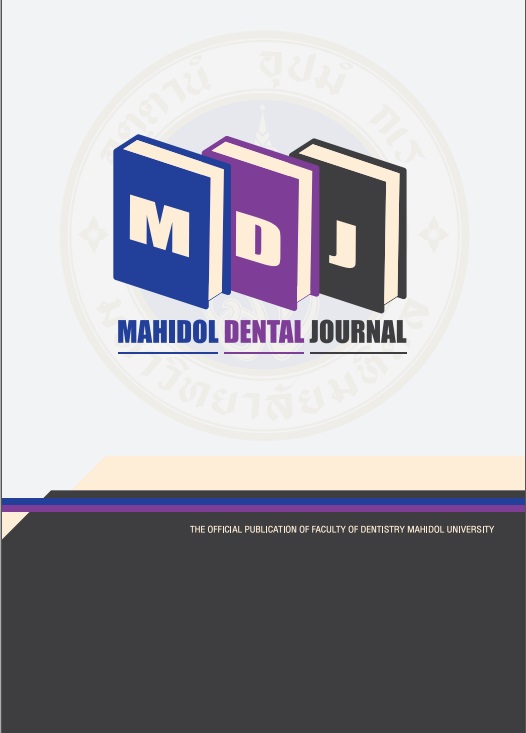The unilateral cleidohyoideus accessorius muscle in human: A case report
Main Article Content
Abstract
Objectives: The infrahyoid muscles are of clinical importance as they serve as anatomical landmarks especially for cervical metastases and surgery. Any variations in this region may cause misdiagnosis and complicate surgical procedures. This study aimed to present a muscular variation of the infrahyoid group, the cleidohyoideus accessorius or accessory cleidohyoid, to raise a concern about additional muscles in the neck region.
Materials and Methods: The infrahyoid region of 394 cadavers was dissected and investigated. The characteristics of the cleidohyoideus accessorius were then recorded.
Results: The unilateral cleidohyoideus accessorius was found in one of 394 Thai cadavers. The additional muscle co-originated with the right clavicular head of the sternocleidomastoid muscle and inserted at the body of the hyoid bone while other infrahyoid muscles were intact. The evolution and clinical considerations of the aberrant muscle were also included.
Conclusion: In the Thai population, the unilateral accessory cleidohyoid can be considered as a rare muscular variation; however, its clinical implications cannot be neglected. Thus, our study can support surgeons in preoperative planning and prevent any unfavourable outcomes.
Article Details

This work is licensed under a Creative Commons Attribution-NonCommercial-NoDerivatives 4.0 International License.
References
Standring S. Gray's anatomy : the anatomical basis of clinical practice. Philadelphia: Elsevier Limited, 2020.
Steinbach K. Uber Varietaten der Unterzungenbein- und Brustmuskulatur. Anatomischer Anzeiger 1923; 15: 488-506.
Sasagawa I, Takahashi K, Igarashi A, Mori H, Kobayashi K. A case of an abnormal bundle from the anterior margin of the right and left trapezius and an abnormality in the right omohyoid appearance in a cadaver. Shigaku 1982; 70: 439-48.
Ozgur Z, Govsa F, Celik S, Ozgur T. An unreported anatomical finding: unusual insertions of the stylohyoid and digastric muscles. Surg Radiol Anat 2010; 32: 513-17.
Kim SD, Loukas M. Anatomy and variations of digastric muscle. Anat Cell Biol 2019; 52: 1-11.
Bregman RA, Thompson SA, Afifi AK, Saadeh FA.Compendium of Human Anatomic Variation: Text, Atlas, and World Literature. Baltimore-Munich: Urban & Schwarzenberg, 1988.
Rai R, Ranade A, Nayak S, Vadgaonkar R, Mangala P, Krishnamurthy A. A study of anatomical variability of the omohyoid muscle and its clinical relevance. Clinics 2008; 63: 521-24.
Robbins KT, Medina JE, Wolfe GT, Levine PA, Sessions RB, Pruet CW. Standardizing neck dissection terminology. Official report of the Academy's Committee for Head and Neck Surgery and Oncology. Arch Otolaryngol Head Neck Surg 1991; 117: 601-5.
Krishnan KG, Pinzer T, Reber F, Schackert G. Endoscopic exploration of the brachial plexus: technique and topographic anatomy - a study in fresh human cadavers. Neurosurg 2004; 54: 401-8.
Stark ME, Wu B, Bluth BE, Wisco JJ. Bilateral accessory cleidohyoid in a human cadaver. Int J Anat Var 2009; 2: 122-23.
Bandarupalli NK, Bolla SR. Bilateral Cleidohyoideus Accessorius Muscle - A Case Report. J Evol Med Dent Sci 2013; 2: 356-59.
Fukuda H, Onizawa K, Hagiwara T, Iwama H. The omohyoid muscle: a variation seen in radical neck dissection. Br J Oral Maxillofac Surg 1998; 36: 399-400.
Chaisiwamongkol K, Sripanidkulchai K, Boonruangsri P, Toomsan Y, Teepsawang S, Songserm L. Cleidohyoid Muscle in Human: A Case Report. Srinagarind Med J 2009; 24: 256-67.
McGonnell IM, McKay IJ, Graham A. A population of caudally migrating cranial neural crest cells: functional and evolutionary implications. Dev Biol 2001; 236: 354-63.
Miura M, Kato S, Itonaga I, Usui T. The double omohyoid muscle in humans: report of one case and review of the literature. Okajimas Folia Anat Jpn 1995; 72: 81-97.
Kerawala CJ, Heliotos M. Prevention of complications in neck dissection. Head Neck Oncol 2009; 1: 35.
Raikos A, Agnihotri A, Yousif S, Kordali P, Saberi M, Brand-Saberi B. Internal jugular vein cannulation complications and elimination of the muscular triangle of the neck due to aberrant infrahyoid muscles. Rom J Morphol Embryol 2014; 55: 997-1000.
Patra P, Gunness TK, Robert R, Rogez JM, Heloury Y, Le Hur PA, et al. Physiologic variations of the internal jugular vein surface, role of the omohyoid muscle, a preliminary echographic study. Surg Radiol Anat 1988; 10: 107-12.
Boudreaux K, Entezami P, Asarkar AA, Ware E, Chang BA. Infrahyoid myocutaneous flap: A systematic review. Am J Otolaryngol 2021; 42: 103133.
Kojima H, Hirano S, Shoji K, Omori K, Honjo I. Omohyoid muscle transposition for the treatment of bowed vocal fold. Ann Otol Rhinol Laryngol 1996; 105: 536-40.
Su CY, Tsai SS, Chiu JF, Cheng CA. Medialization laryngoplasty with strap muscle transposition for vocal fold atrophy with or without sulcus vocalis. Laryngoscope 2004; 114: 1106-12.


